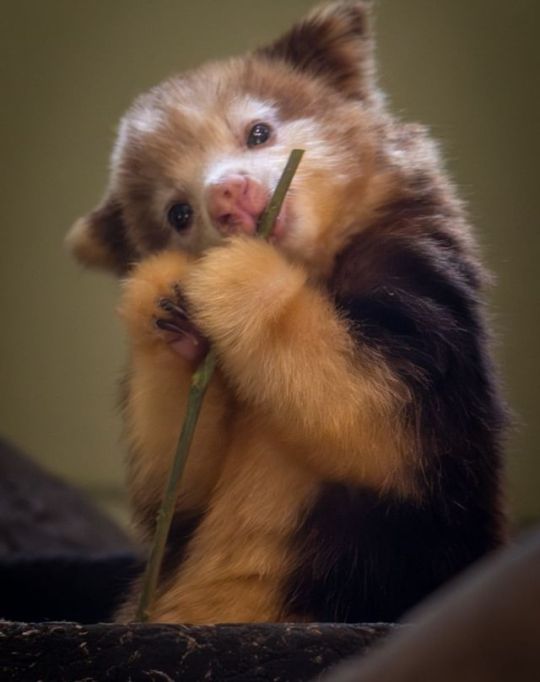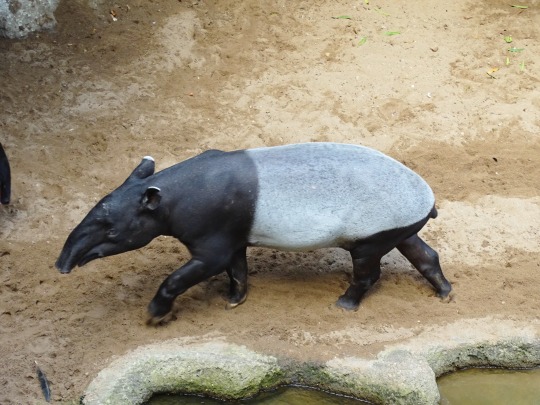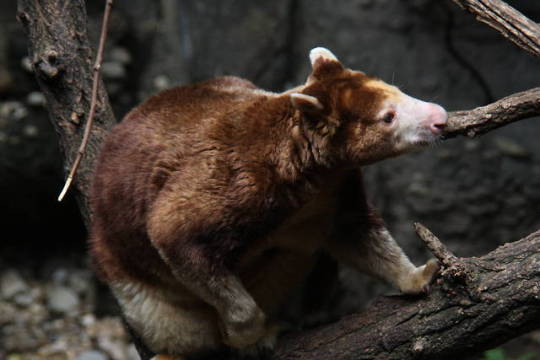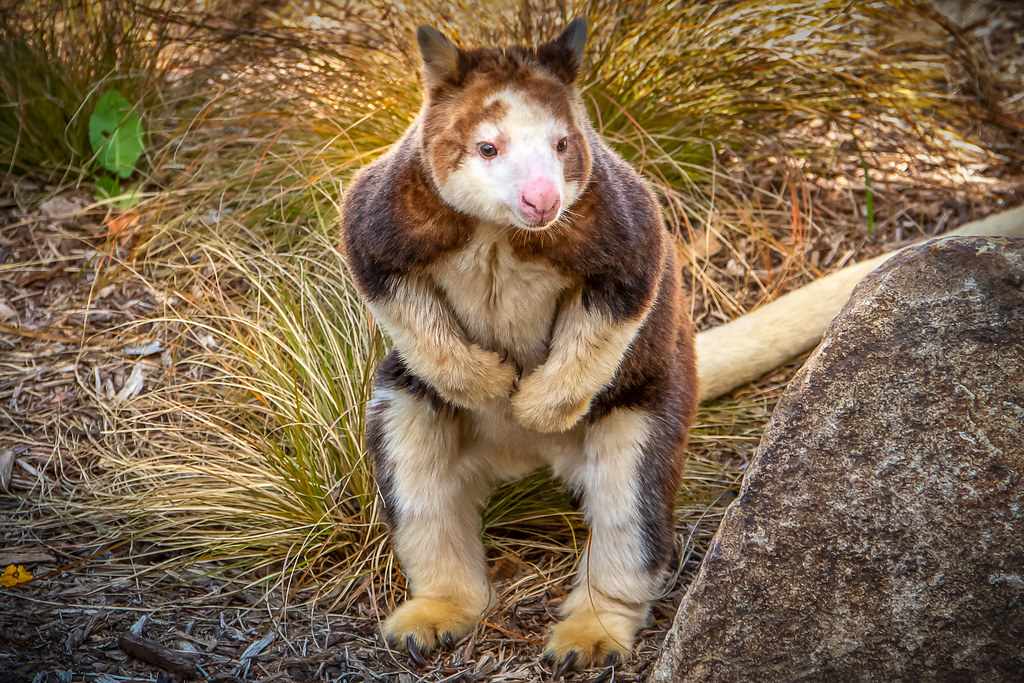#matschiei
Text

Matschie's Tree Kangaroo
#matschies tree kangaroo#tree kangaroo#Dendrolagus matschiei#Marsupialia#Diprotodontia#Macropodidae#Dendrolagus#upl
16 notes
·
View notes
Text
Tree Kangaroos and Rufous Bettongs are largely solitary, although they sometimes associate in pairs, trios, or small groups of adults and their young.

"Biological Exuberance: Animal Homosexuality and Natural Diversity" - Bruce Bagemihl
#book quotes#biological exuberance#bruce bagemihl#nonfiction#rufous bettong#rat kangaroo#aepyprymnus rufescens#doria's tree kangaroo#dendrolagus dorianus#matschie's tree kangaroo#dendrolagus matschiei#solitary#pair#trio#small group
0 notes
Text

Giant Monkey-tailed East Usambara Two-horned Chameleon (Kinyongia matschiei), family Chamaeleonidae, Amani Reserve, Tanzania
ENDANGERED.
Photograph by Artur Bujanowicz
209 notes
·
View notes
Photo

Matschie’s Tree-Kangaroo (Dendrolagus matschiei) at the Kansas City Zoo #worldtreekangarooday https://www.instagram.com/p/Cd0_ghOr_uk/?igshid=NGJjMDIxMWI=
0 notes
Video
Cuteness in the Grass by Helene Hoffman
Via Flickr:
Female Matschie's tree-kangaroo (Dendrolagus matschiei) named "Polly". Native to Eastern Papua New Guinea, "Polly" and the male "Spike" are one of the newest addition to the Walkabout Australia habitat at the San Diego Zoo Safari Park. Conservation status: Endangered
#tree kangaroo#Dendrolagus matschiei#Papua New Guinea#San Diego Zoo Safari Park#Huon tree-kangaroo#Conservation Status: Endangered#Matschie's tree-kangaroo#animal#Walkabout Australia#macropod#mammal#Marsupial#coth5#nature
32 notes
·
View notes
Photo

Matschie’s tree-kangaroo (Dendrolagus matschiei)
Photo by Peter Schouten
#matschie's tree kangaroo#huon tree kangaroo#tree kangaroo#dendrolagus matschiei#dendrolagus#macropodinae#macropodidae#macropodoidea#macropodiformes#diprodontia#australidelphia#marsupialia#metatheria
24 notes
·
View notes
Video
Matschie's Tree-kangaroo (Dendrolagus matschiei) by Paul Chudyk
#Detroit Zoo#Zoo#Summer Zoomance#Nikon#D300#Nikon D300#MI#Argent Imaging#Matschie's Tree-kangaroo#Dendrolagus matschiei#huon tree kangaroo#tree kangaroo#marsupial#australian animals
6 notes
·
View notes
Photo

Matschie’s Tree Kangaroo
Dendrolagus matschiei
Source: Here
#matschie's tree kangaroo#tree kangaroo#kangaroo#marsupial#marsupials#animal#animals#wildlife#nature
384 notes
·
View notes
Photo










Bronx Zoo, New York City (No. 41)
Matschie's tree-kangaroo (Dendrolagus matschiei), also known as the Huon tree-kangaroo is a tree-kangaroo native to the Huon Peninsula of northeastern New Guinea island, within the nation of Papua New Guinea.
Under the IUCN classification, Matschie's tree-kangaroo is an Endangered species.
The scientific name honours German biologist Paul Matschie.
With a body and head length of 20 to 32 inches (51–81 cm), Matschie's tree-kangaroo are much smaller than Australia's well-known red kangaroo. An adult male weighs between 20 and 25 lb (9–11 kg). An adult female weighs between 15 and 20 lb (7–9 kg)
There is no particular season in which they breed. Gestation lasts 44 days and joeys of captive bred individuals leave the pouch after 11 months. The average life span of the Matschie's tree-kangaroo in the wild is unknown, but is at least 14 years. The life span of the kangaroo in a zoo is about 20 years.
The most distinctive trait of all tree-kangaroos is the hair whorl they possess. It is a patch of hair that goes out in many directions and its location ranges from up near the shoulders all the way down to the tail. The Matschie's tree-kangaroo is golden on its ventral side, lower parts of its limbs, ear edges, belly, and tail, and the rest of its body is a chestnut brown colour, except for usually having a dark stripe down its back. Their faces are typically an array of yellow and white colours. The Matschies’ are similar in colour and size to Dendrolagus dorianus, the Doria's tree-kangaroo. Matschies’ ears are small and bear-like looking and they do not have a good sense of hearing because of it. They have curved claws on their forelimbs and soft pads on their hind limbs that aid in their climbing ability, and they have some independent movement of their digits as well as good dexterity due to their forelimbs being able to bend a great deal. The 4th and 5th digit of their feet are enlarged, the 1st digit is absent, and the 2nd and 3rd digits are syndactylous (two digits that look like one fused together). Scientists have discovered that the Matschie's are able to walk bipedally and there's a lot of rotation in their limbs for climbing. Out of all of the Dendrolagus species, the Matschie's tree-kangaroo is the best vertical climber and has more strength in its muscles than any others. Their tails help to offset their balance while moving swiftly through the trees since their tails are about the same length as their head and body size. Sexual dimorphism is very low, with males and females being of about equal sizes. The upper and lower jaws of the Matschie's tree-kangaroos are different too in addition to them being different in body size. The upper jaw has three incisors, one canine, one premolar, and four molars, while the lower jaw has one very sharp incisor, no canines and low crowned molars.
Source: Wikipedia
#Huon tree-kangaroo#Bronx Zoo#JungleWorld#my favorite zoo#animal#USA#indoors#Total Experience attraction#worth the money#New York City#summer 2018#reptile#sailfin lizard#Malayan tapir#Asian Tapir#landmark#tourist attraction#cityscape#nature#flora#fauna#tree#close up#detail#original photography#Northeastern USA
4 notes
·
View notes
Photo




Matschie’s tree kangaroo [also known as the Huon tree kangaroo, Dendrolagus matschiei] is a rare marsupial native to the Huon Peninsula of New Guinea island. At an average of 20-25 pounds, these kangaroos are much smaller than Australia’s famous red kangaroos, and have a largely arboreal lifestyle in which they descend to the forest floor only to feed. This specimen and her joey live at Zoo Miami in Florida. Images by Joel Sartore.
317 notes
·
View notes
Photo

Oh my Spirals! Drawing the next animal for my rare species coloring book, the Usambara Blade horned Chameleon (Kinyongia matschiei) found in the Tanzanian Eastern Usambara Mountains. Stay tuned to see the final drawing and find out more about these amazing endangered creatures! 🌏 💫🌱🐾 Sign up For the newsletter and check out the blog at 👉👉 Lastchanceearth.com #chameleon #Usumbara #lizard #Tanzania #Kinyongiamatschiei #beautiful #wildlife #amazing #drawing #art #climatechange #iganimals #racingextinction #endangered #endangeredspecies #coloringbook #savethem #sacredgeometry #animallovers #conservation #naturalillustration #adultcoloringbook #spooky #magical #lastchanceearth
#drawing#lizard#iganimals#amazing#racingextinction#savethem#spooky#coloringbook#climatechange#naturalillustration#usumbara#magical#kinyongiamatschiei#chameleon#tanzania#endangered#beautiful#art#lastchanceearth#animallovers#endangeredspecies#conservation#adultcoloringbook#wildlife#sacredgeometry
2 notes
·
View notes
Photo

Jersey Devil
Kingdom: Animalia
Phylum: Chordata
Class: Mammalia
Clade: Metatheria
Infraclass: Marsupalia
Order: Diprotodontia
Suborder: Macropodiformes
Family: Deinocapridae
Genus: Deinocapra
Species: D. horrificus (”horrifying terrible goat”)
Ancestral species: Dendrolagus matschiei (Matschie’s tree-kangaroo)
Time period: early Solocene (105 million years to 110 million years in the future).
Information: named after the North American cryptid it resembles, the Jersey Devil is perhaps the most short-lived species we’ve come across so far. It only exists for 5 million years during the Solocene before going extinct. The extinction of the species is attributed to the overpopulation of carnivorous species in the region, meaning that the species had too much competition for food. During its time, however, it is a formidable predator. Standing 6 feet tall and 10 feet long, this macropod lives across eastern Thalassia, where it actively hunts small prey animals, using its dagger-like teeth to kill. The horns are an evolutionary that only males have for fighting for mating rights during the mating season. Its hair is primarily grey, though brown-haired individuals do exist.
0 notes
Link

Matschies tree kangaroo also known as the Huon tree kangaroo, Dendrolagus matschiei is a rare marsupial native to the Huon Peninsula of New Guinea island. At an average of 20-25 pounds, these kangaroos are much smaller than Australias famous red kangaroos, and have a largely arboreal lifestyle in which they descend to the forest floor only to feed. This specimen and her joey live at Zoo Miami in Florida. Images by Joel Sartore.
0 notes
Text
Dendrolagus matschiei aka the cutest but weirdest thing ever
0 notes
Photo

Matschie’s tree-kangaroo (Dendrolagus matschiei)
Photo by Giant Eland
#matschiei's tree kangaroo#huon tree kangaroo#tree kangaroo#dendrolagus matschiei#dendrolagus#macropodinae#macropodidae#macropodoidea#macropodiformes#diprodontia#australidelphia#marsupialia#metatheria#tetrapoda#vertebrata#chordata#captive animal
1 note
·
View note
Text
Huon Tree Kangaroo
Dendrolagus matschiei
Dendrolagus translates into tree hare, while matschiei is in honor of biologist and ex-Berlin zoo curator Paul Matschie.
Family: Macropodidae (Kangaroo Family)
Fun Fact: “Tree kangaroos are very agile in trees and can travel rapidly from tree to tree, leaping as much as 9 meters down to an adjoining tree... They can jump down as much as 18 meters without injury“ (ADW)
Habitat: They are endemic to montane forests of Papua New Guinea, specifically on the Huon Peninsula.
Ecosystem Role: They are foliovores (leaf-eaters) that help pruning and regeneration of tree species. They have no known predators, besides humans, but likely larger birds of prey will hunt them.
Conservation Status: Endangered
2 notes
·
View notes
